Waikiki’s history extends far back. Rising from a swampland, Waikīkī, which translates to “spouting waters”, offered a protected beach, multiple water sources and good, flat ground to build fishponds and taro fields. It was an easy choice for this area to become the cultural and governmental center of the island under Chief Kalamakua in the 1400s.
Waikīkī: 14 square miles packed with aloha
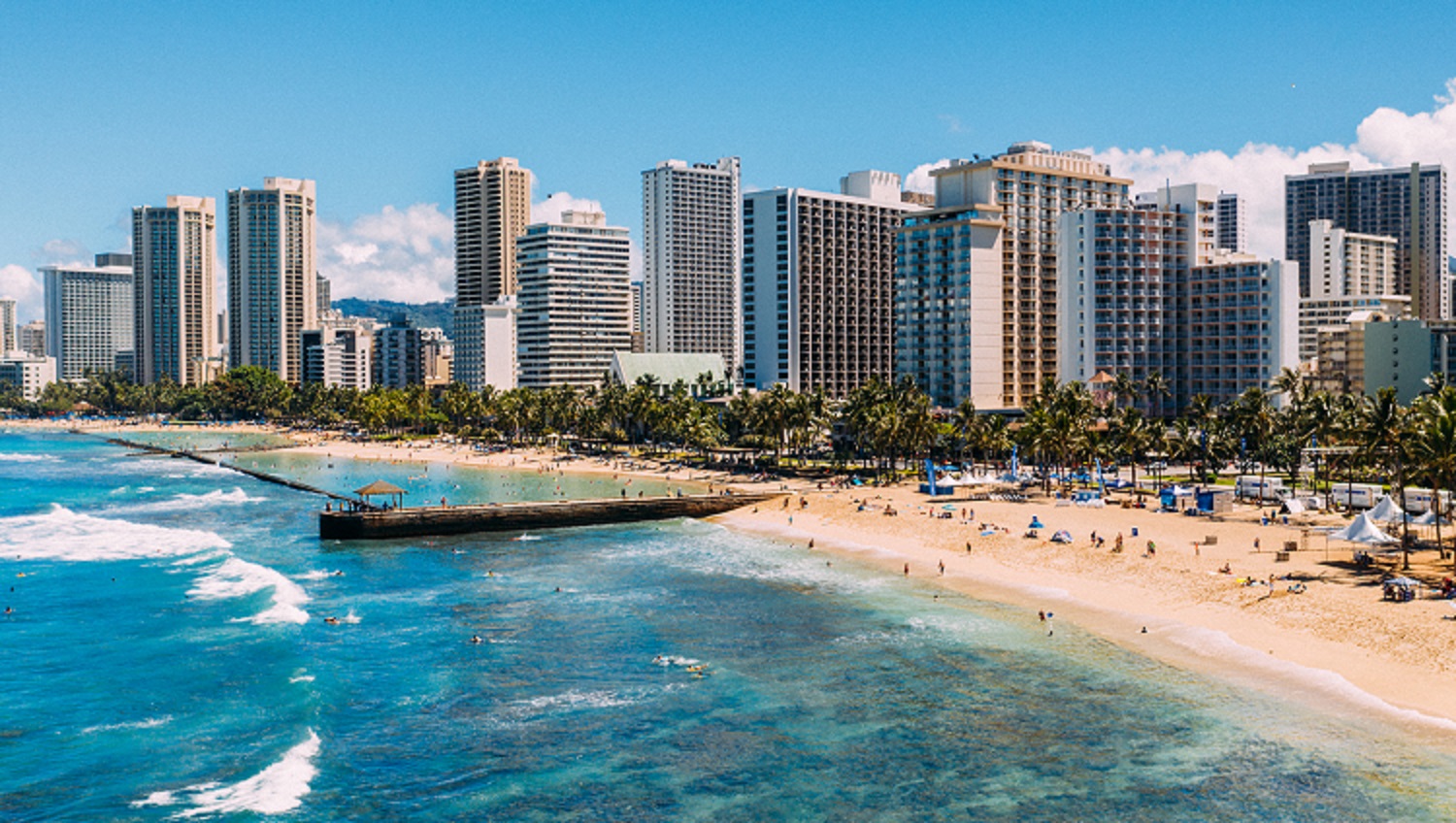
A view of Waikiki from Queens Beach. Photo courtesy of Hawai‘i Tourism Authority, Vincent Lim photographer
Today, we find a thriving, and crowded tourist and commerce center, which provides more tourist activities per square mile than anywhere else on any of the Hawaiian Islands.
The most predominate area is the famous Waikīkī Beach, a great place to play day or night, which offers lots of sand, waves, entertainment and a great spot to learn how to surf. Just remember that water shoes are the norm since coral rocks dot the entire area, which is not fun to step on barefooted!
As Oʻahu entered the age of international travel, it became the ‘go to’ site for tourists seeking a few days paradise. Surfing, which is truly Hawaiian born, became a world-wide sensation due to one Waikīkī local, Duke Kahanamoku. A Hawaiian native, Duke’s career included being an actor, cultural spokesperson, Honolulu Sheriff and winner of multiple Olympic medals in swimming and water polo. He traveled around the globe to showcase his amazing skills and promote the ‘sport of kings’. By the 1950s, Waikīkī was known the world over for both its active day and night life scene.
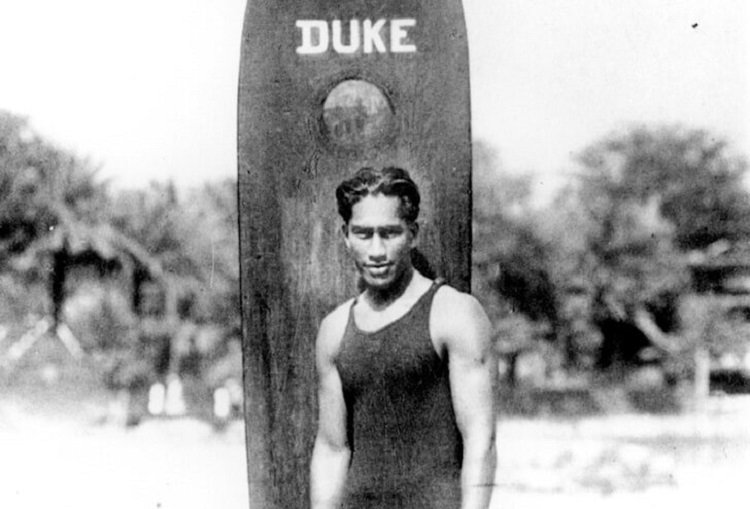
Duke Kahanamoku, c. 1910. Photo courtesy of Surfer Today magazine
Considering that the vast majority of visitors will utilize one of the over 30,000 rooms available around Waikīkī Beach, it is most likely that you will find yourself exploring the sights, sounds and tastes of this beach side metropolis. There is relative safety in being among the crowd but remember that there is an elevated homeless population on the island, and to keep your valuables protected and close to you at all times.
For those interested in finding accommodations in a more rural section of Oʻahu, click here for a review of available lodging along the North Shore.
A few recommendations in Waikīkī:
- There is an amazing street market along Kalakaua Ave., which is the main road running along Waikīkī Beach, every Friday evening in the summer. It starts at the Moana Surfrider and extends to the west for a few blocks. This closes the area to any traffic, so plan accordingly.
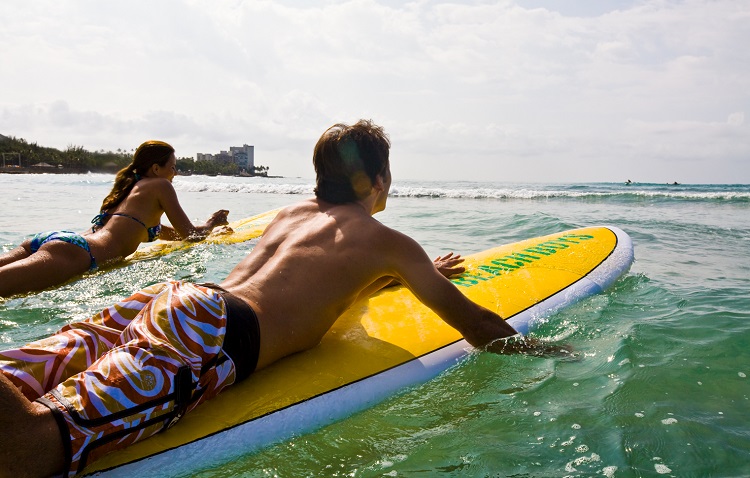
Surf lessons are easy to find along Waikiki Beach. Photo courtesy of the Hawai‘i Tourism Authority/Tor Johnson
- You can get an easy surf lesson straight out from the main police station along Waikīkī Beach (just to the left of Moana Surfrider Hotel). There are a few vendors to choose from in that area.
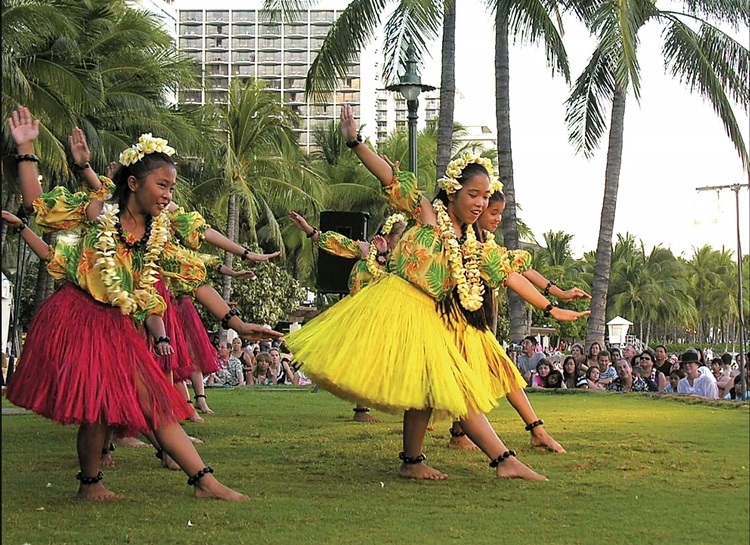
Come to the Torch Lighting and Hula Show at Kuhio Beach. Photo courtesy of the Waikiki Improvement Association
- A free hula presentation is held every Tuesday, Thursday, and the last Saturday of each month in the early evening along the section called Kuhio Beach. Look for a performance area close to the Duke Kahanamoku statue directly across from the Hyatt Regency Waikiki. Find out more at: https://www.waikikiimprovement.com/events
- For a relaxed area perfect for families, joggers, skaters and sunset yoga classes, go to Magic Island Park. This is a small but popular man-made peninsula adjacent to Ala Moana Beach Park and the Ala Wai Yacht Harbor where you will find a protected lagoon, and grassy park.

Come enjoy the largest shopping mall in Hawai‘i at the Ala Moana. Artwork courtesy of the Ala Moana Shopping Center
- Speaking of Ala Moana, if shopping is on your list of ‘to dos’, you’ll find it at the Ala Moana Shopping Center. Here you will find a massive, 4 story outdoor mall with everything from the high end stores like Neiman Marcus and Prada, to a 3 story Target.
Waikiki v. Hukilau Beach
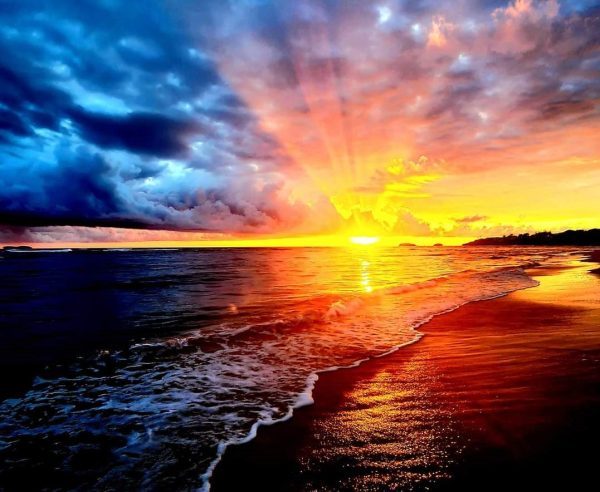
The beautiful Hukilau Beach in Lāʻie is great for swimming, playing in the waves and it’s gorgeous sunrise.
Comparing apples and oranges
Comparing Waikīkī to the beaches surrounding the community of Lāʻie, where the Polynesian Cultural Center is found, is like comparing Los Angeles to Santa Cruz. But let’s try. We’ll use Hukilau Beach Park at Lāʻie Bay (which locals just call Hukilau). We chose yet away from the dangerous rock outcroppings common among many of the island’s beaches. If you just want to play in the waves, do a little body surfing, or catch some rays, both beaches are among the favorites across the island.
Obvious differences
Now for the differences. Waikīkī offers everything within an easy walking distance, such as public restrooms, restaurants, an abundance of stores, sports rental kiosks and hundreds upon hundreds of hotels.
Hukilau has a more 50s, laid back vibe. There are no restrooms , though there are plenty at the Polynesian Cultural Center and at the local Lāʻie Shopping Center. They do, however, have an outdoor shower. There is one hotel – the Courtyard by Marriott Oʻahu North Shore and a few rentals. Additionally, the beautiful Turtle Bay Resort is just 6 miles north. Food can be found within a couple of blocks, at either Ken’s Fish or the world famous Hukilau Café (both of which only serve take out orders at this time.) Please note that both eateries are closed Sunday and Monday. Ken’s Fish opens around 11 and closes around 4pm. Hukilau Café is a breakfast place – with lunch also served on Fridays and Saturdays. But just a few miles north or south will provide plenty of food choices, including a number of eateries at the Hukilau Marketplace – which is just one mile away.
Most obviously, Waikīkī is constantly crowded, while Hukilau is wide open. Just remember that the parking lot at Hukilau, which is free (another big difference from Waikiki) is locked from 8pm – 6am. Don’t chance getting stuck for the night – as soon as it is turning dark, it’s time to head out.
Activities along Waikīkī includes barbecue grills, volleyball nets and even a zoo and aquarium. Hukilau is a simple little no frills park. What it does offer is a chance to really relax and simply enjoy a great day in the sun.
Bio of Nina S. Jones, Blogger for the Polynesian Culture Center

Nina Jones, a mainland gal from way back, is now a transplanted Islander. With her husband of 39 years, she volunteers at the Polynesian Cultural Center. Her hobbies include swimming, traveling, studying and writing about what she is learning from the various Polynesian cultures. Her blogs focus on their history, beliefs, practices and – as an added bonus – delicious food! To her, Polynesia is not just a place to visit, it is a way to live and she is very honored to be able to be a part of their amazing world.



Recent Comments